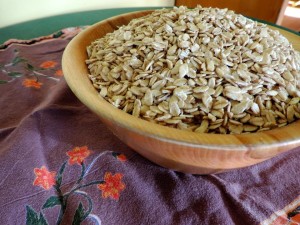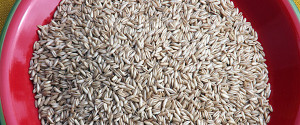Local up your breakfast with Nash’s farm-raised and rolled oats! More nutty and flavorful than traditional rolled oats, ours make amazing oatmeal, granola, cookies and more. A thick rolled oat, we recommend a slightly longer cooking time for breakfast cereal. Keep an eye out for hulls that sneaked through our cleaner, and scoop them off of the top of your saucepan, as they float to the top when combined with water. Because of the fiber combination found in oats, they have been shown to lower cholesterol levels time and time again in research studies. They also offer a unique antioxidant family called avenanthramides (say that ten times fast!) that has been shown to reduce the risk of cardiovascular disease.
Nash’s oats are a bit different than what you find on the average grocery shelves, as they’re the least processed of the bunch, leaving a whole grain product just as nature intended. Because of the minimal processing, our oats will store in an air-tight container in a dimly lit space for months.
An Oat Education
Oat groats—unflattened kernels that are good for using as a breakfast cereal or for stuffing.
Steel-cut oats—have a dense and chewy texture, and are produced by running the grain through steel blades that thinly slice them.
Old-fashioned oats—have a flatter shape that is the result of their being steamed and then rolled.
Quick-cooking oats—processed like old-fashioned oats, except they are cut finely before rolling.
Instant oatmeal—produced by partially cooking the grains and then rolling them very thin. Oftentimes, sugar, salt and other ingredients are added to the finished product.
Oat bran—the outer layer of the grain that resides under the hull. While oat bran is found in rolled oats and steel-cut oats, it may also be purchased as a separate product that can be added to recipes or cooked to make a hot cereal.
Oat flour—used in baking, it is oftentimes combined with wheat or other gluten-containing flours when making leavened bread.


